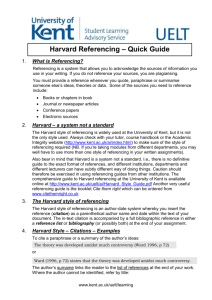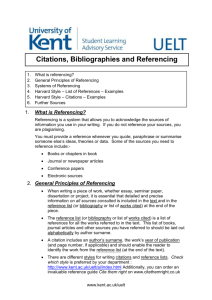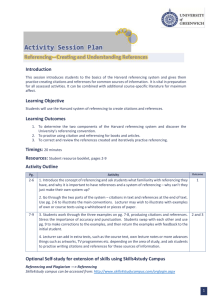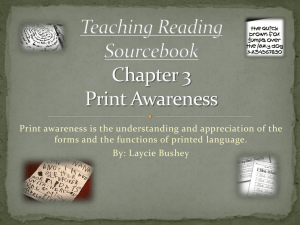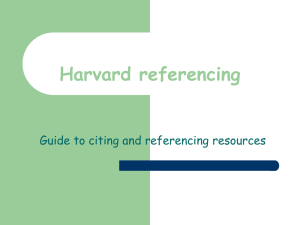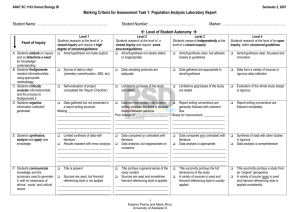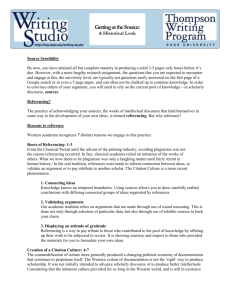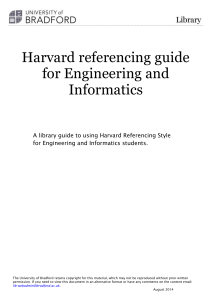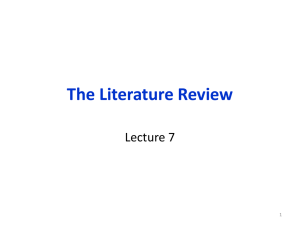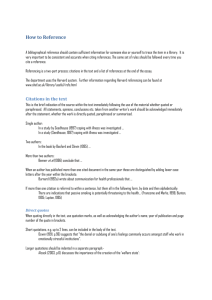Harvard Referencing Guide for Optometry
advertisement
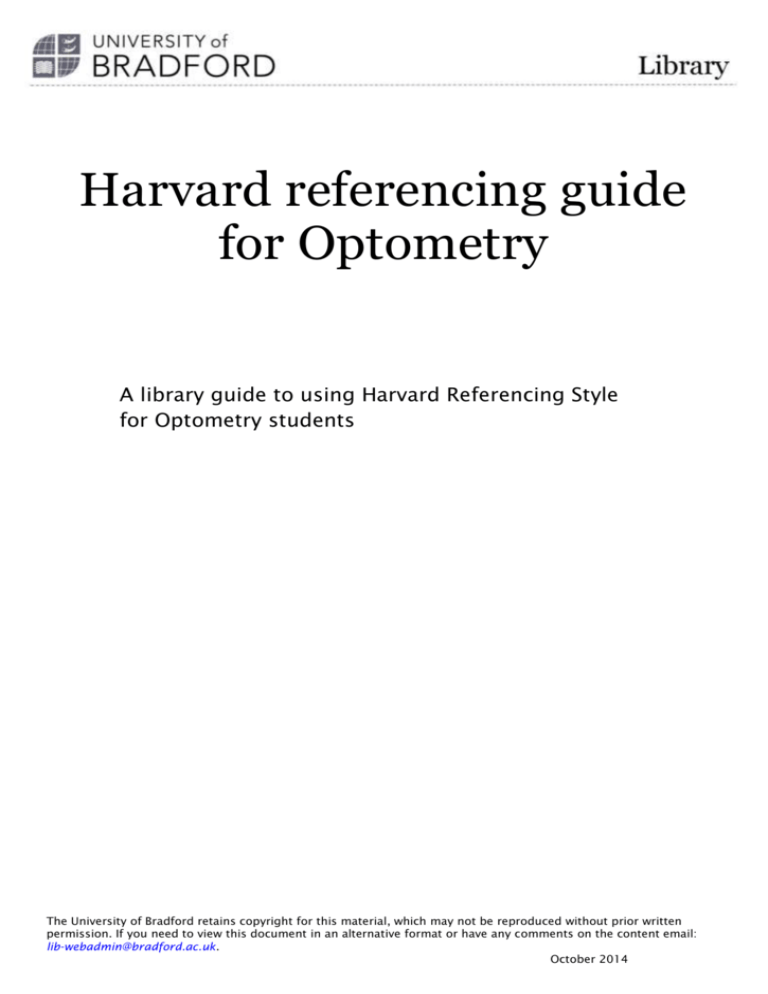
Harvard referencing guide for Optometry A library guide to using Harvard Referencing Style for Optometry students The University of Bradford retains copyright for this material, which may not be reproduced without prior written permission. If you need to view this document in an alternative format or have any comments on the content email: lib-webadmin@bradford.ac.uk. October 2014 Contents Introduction ................................................................................................................................ 1 Why do I have to reference? ......................................................................................................... 1 How to reference using the Harvard style .................................................................................... 1 What is the reference list? ........................................................................................................ 2 How do I cite the references in the text? ................................................................................... 2 Do I include page numbers in the citation? ............................................................................... 2 A direct quotation: ............................................................................................................... 2 Paraphrasing: ....................................................................................................................... 2 If I read a book that cites another author’s work and I want to use it, how do I reference it? ..... 3 Secondary referencing: ......................................................................................................... 3 What abbreviations can I use?................................................................................................... 3 Should I use the full web site address? ..................................................................................... 3 Points to remember.................................................................................................................. 3 I need to reference something that isn’t in this document ........................................................ 4 Book ............................................................................................................................................ 4 Reference order: ................................................................................................................... 4 Example ............................................................................................................................... 4 Chapter in an edited book ........................................................................................................... 5 Reference order: ................................................................................................................... 5 Example ............................................................................................................................... 5 Electronic book (e-book) .............................................................................................................. 5 Journal article .............................................................................................................................. 5 Reference order: ................................................................................................................... 5 Example ............................................................................................................................... 6 Webpage ..................................................................................................................................... 6 Reference order .................................................................................................................... 6 Example ............................................................................................................................... 6 Standard published on the internet .............................................................................................. 7 Reference order .................................................................................................................... 7 Example ............................................................................................................................... 7 Dissertation or Thesis.................................................................................................................. 7 Reference order .................................................................................................................... 7 Example ............................................................................................................................... 8 Harvard referencing guide for Optometry Report- for example a market research report ............................................................................. 8 Reference order .................................................................................................................... 8 Example ............................................................................................................................... 8 Visual source from a book - e.g. illustration/ figure/ diagram/ table ............................................ 9 Reference order .................................................................................................................... 9 Example ............................................................................................................................... 9 Photograph from online collection ............................................................................................... 9 Reference order .................................................................................................................... 9 Example ............................................................................................................................. 10 Online video- for example, film on YouTube® ............................................................................ 10 Reference order .................................................................................................................. 10 Example ............................................................................................................................. 10 Further help .............................................................................................................................. 10 This is an example of how your reference list should look: ................................................. 11 Reference List ............................................................................................................................ 11 October 2014 Harvard referencing guide for Optometry Introduction Why do I have to reference? References are important. They demonstrate that you have read the relevant information, that you know how to present research in a scientific and professional manner and that you are not attempting to plagiarize the work of someone else. Furthermore, the most important purpose of referencing is to let the reader know where a piece of information comes from so that they can find the original paper, book etc, for themselves. Students sometimes become so caught up in the minutiae of referencing that they miss the big picture and make big mistakes. Always bear in the mind the following principles: 1) The reader must be able to know, in principle, where to find the item cited. 2) Every citation in the text must correspond to a reference in the reference list. 3) Every reference in the reference list must correspond to a citation in the body of the text. 4) A consistent referencing format must be used (eg order of authors, date and title the same in all cases). This won’t happen if you simply cut and paste references into your reference list without checking that the format is appropriate. 5) The format used should be the format asked for. For your third-year project this is the Harvard Referencing System described here. The following description summarises the method. For examples of how to reference different kinds of source, you can look at the guide for Engineering and Informatics students (who use the same style) http://www.brad.ac.uk/library/help/referencing/harvard-referencing-guide-forengineering-and-informatics/, or the guide for Health Studies students, (who use a very similar style, and have examples of things such as organisational policies that may be useful to you) http://www.brad.ac.uk/library/files/course/harvard-ref/index.htm, or look at the book Cite Them Right by Pears and Shields (9th edition, 2013) which is in the library at 808.027 PEA. How to reference using the Harvard style There are several different ways of citing references within the body of a report. The Harvard system uses the author’s name and year of publication within the text, and an alphabetic listing of names in the references. This is the style that the Division uses. (Some systems use numeric methods by using numbers as superscripts 2 or in parentheses [2] to refer to other studies listed in the reference section. Do not use this method.) 1 October 2014 Harvard referencing guide for Optometry What is the reference list? This appears at the end of your document. It is the list of the sources that you have used. (It is not added to your word count). The references should contain enough detail to enable another reader to find and locate the exact text you are referring to. How do I cite the references in the text? When you refer to another document you must acknowledge this within the text of your work, by citing the author’s surname and the date of publication. For a single author: Richards (1963) found an interocular transfer of luminance modulation and…. For up to three authors: When citing something written by up to three authors list them all. Smith and Jones (1972) disagree with earlier authors, and find….. For four or more authors: For more than three authors cite the first name listed followed by ‘et al.’ Blair et al. (1995) investigated….. Do I include page numbers in the citation? If you quote the exact words of your source, or copy an image, table or illustration, you need to include the page number where you found your quotation. If you paraphrase (put the information from the source into your own words) you do not need to include the page number. A direct quotation: ‘As a complex, delicate and superficial organ, the eye is reasonably well protected within the bony orbit.’ (Field and Tillotson, 2007, p.1) Paraphrasing: The bones around the eye protect it fairly well. (Field and Tillotson, 2007) 2 October 2014 Harvard referencing guide for Optometry If I read a book that cites another author’s work and I want to use it, how do I reference it? Secondary referencing: This is explained by Pears and Shields as, “In some cases you will read a source that refers to the work of someone else, known as a secondary source. Preferably you should find and read the item referred to. However, where this is not possible and you still wish to include the work referred to, you can mention it as a citation, known as secondary referencing.” (2010, p.8) You must cite the authors of the book you are using and the page number where they use the authors work you want to refer to. As far as possible you should try to read the original articles. Citing secondary sources is appropriate if the original is either difficult to obtain (e.g. a very old article), or is difficult to read (e.g. an article in a language other than English). Citing a secondary source for an article that is readily available (either through the library or through interlibrary loans) indicates an unwillingness to put in the necessary effort to obtain or to read the original article. Example: Richards (1963, as cited by Smith and Jones, 1972) found an interocular transfer of luminance modulation whilst Smith and Jones (1972) were unable to replicate this finding. What abbreviations can I use? 1. Abbreviate editor to (ed.). 2. Abbreviate edition to edn. Should I use the full web site address? You don’t have to put in the whole URL (web address). Cut it down so that it gives the reader enough information to identify the journal article / web page. Points to remember 1. Write all the authors’ names in the reference list, not just the first two and ‘et al’. 2. Your reference list should be in alphabetical order. (A - Z). 3. Always write the surname (family name) first followed by initials of personal names. 4. Only use a capital letter for the first significant word in the title. (Except when you are writing a journal title). 5. You may see an “issue” called a ‘part’ or ‘number’ instead; it may be shown with a number, a month name, or a letter. It is the part within the year. For example, you may see “Volume 5, issue 6”; “Volume 5, number 6”, “Volume 5, June issue”, or 3 October 2014 Harvard referencing guide for Optometry “Volume 5, supplement II”. All of those are ways of showing which part of the volume you are looking at. 6. You can usually find the issue number and volume on the front cover. 7. You will often see the information in a different order on the journal article PDF, or the cover of the book, from how we show it here- for example, they often write the author’s name in the order ‘personal name then surname’. Make sure you don’t just copy this into your reference, but change it so that it follows the rules of the Harvard style- for example, ‘surname then initial of personal name’. 8. ‘Place of publication’ means town or city. Not country, and not street address. I need to reference something that isn’t in this document There are more examples of references for different kinds of source in Pears, R. and Shields, G. (2013) Cite them right: the essential referencing guide. 9th edn. Basingstoke: Palgrave Macmillan. (Copies are in the JB Priestley Library at classmark 808.027 PEA.) Book Reference order: Author / editor (surname followed by initials). Year of publication (in round brackets). Title (In italics). Edition (Only include the edition if it is not the first one). Place of publication: publisher. Series (where relevant). Example In-text citation Grosvenor (2006) explains that…. Reference Grosvenor, T. (2006) Primary care optometry. 5th ed. St Louis, MO: ButterworthHeinemann. 4 October 2014 Harvard referencing guide for Optometry Chapter in an edited book Reference order: Author(s) of chapter or section (surname followed by initials). Year of publication (in round brackets). Title of chapter or section: subtitle if it has one (in single quotation marks) then ‘in’. Editor(s) of book (surname followed by initials) then ‘ed.’ (in round brackets) if there is one editor or ‘eds.’ (in round brackets) if there are more than one. Title of book: subtitle if it has one (in italics). Place of publication: publisher. ‘pp.’ then the page numbers where the chapter starts and ends. Example In-text citation Bergkamp et al. (1994) raise issues of vision for high performance in sport … Reference Bergkamp, D., Asprilla, F. and Ravanellli, F. (1994). ‘Sports vision’. In Hoddle, G. (ed), Modern theories of vision. London: Butterworths, pp.110-129. Electronic book (e-book) If the online source includes the same details as the print version, reference it in the same way. On some devices the specific page details are not available. Use the information you do have, for example (Brasier, 2009, 70%). Journal article As the majority of journal articles are available online, you only need to include enough information to let your reader find the article. Usually this means you don’t need to include the URL. If you are specifically referencing an abstract of a journal article your citation should make this clear. Reference order: Author(s) of article (surname followed by initials). Year of publication (in round brackets). Title of article: subtitle if it has one (in single quotation marks). 5 October 2014 Harvard referencing guide for Optometry Title of journal (in italics – capitalise first letter of each word in title, except for linking words such as and, of, the, for). Issue information, that is, volume number (not in brackets) and, where applicable, the part number, supplement number, or month/season of the issue (in round brackets). ‘pp.’ then the page numbers where the article starts and ends. doi (if available). Example In-text citation …who present a useful framework for analysis (Smith and Jones, 1972). Reference Smith, J.P. & Jones, A. (1972). ‘Lack of interocular transfer of luminance modulation.’ Vision Research, 210(10), pp.1605-1609. Webpage Reference order Author of page- may be a person (give surname and initials) or an organisation (give name as listed on the website’s home page). Year page was published or last updated (in round brackets). Title of web page (in italics). ‘Available at:’ URL. ‘(Accessed: date)’. Example In-text citations …the values of an optometrist (Association of Optometrists, 2013). A simple guide has been created by Marshall (2014). References Association of Optometrists. (2013) Mission, values, vision and goals of the AOP. Available at: http://www.aop.org.uk/about-the-aop/mission-vision-values-and-goals (Accessed: 8 September 2014) 6 October 2014 Harvard referencing guide for Optometry Marshall, B. (2014) How two-stroke engines work. Available at: http://science.howstuffworks.com/two-stroke.htm (Accessed: 22 July 2014). Standard published on the internet Reference order Name of authorising organisation. Year of publication (in round brackets). Number and title of standard (in italics). Available at: URL. (Accessed: date). Example In-text citation The standard (British Standards Institution, 2013) prescribes how to… Reference British Standards Institution (2013) BS ISO/IEC 27001:2013: Information technology: security techniques: information security management systems: requirements. Available at: http://bsol.bsigroup.com (Accessed: 22 July 2014). Dissertation or Thesis Reference order Author. Year of submission (in round brackets). Title of thesis (in italics). Degree awarded. Body who awarded the degree. If you viewed the thesis online: ‘Available at:’ URL. ‘(Accessed: date)’. 7 October 2014 Harvard referencing guide for Optometry Example In-text citations In a previous Masters dissertation (Khan, 2009) the review found… Yulei (2010) shows that in practice… References Khan, M.K.H. (2009) Simulation study of VLANS, 802.3 and security issues. MSc dissertation. University of Bradford. Yulei, W. (2010) Performance modelling and evaluation of heterogeneous wired / wireless networks under Bursty Traffic: analytical models for performance analysis of communication networks in multi-computer systems, multi-cluster systems, and integrated wireless systems. PhD thesis. University of Bradford. Available at: http://bradscholars.brad.ac.uk/handle/10454/4423 (Accessed: 22 July 2014). Report- for example a market research report Reference order Author or organisation. Year of publication (in round brackets). Title of report (in italics). Place of publication: publisher. OR if accessed on the internet: Available at: URL. (Accessed: date). Example In-text citations The energy market is predicted to grow (Keynote, 2010)…. Workability was quantified by the ACI Committee (2008), who found… 8 October 2014 Harvard referencing guide for Optometry References ACI Committee (2008) Report on measurements of workability and rheology of fresh concrete, 238. Farmington Hills: American Concrete Institute. Keynote (2010) Energy industry: market review. Available at: https://www.keynote.co.uk/ (Accessed: 12 January 2011). Visual source from a book - e.g. illustration/ figure/ diagram/ table Reference order Author of book (surname followed by initials). Year of publication (in round brackets). Title of book (in italics). Edition. Place of publication: publisher. Page number of illustration etc. ‘Illus’. / ‘fig.’ / ‘diagram’/ ‘logo’ / ‘table’ (followed by number if known). Example In-text citation Handy and Spangler (2007) show that….. Reference Handy, R.L. and Spangler, M.G. (2007) Geotechnical Engineering, 5th edn. London: McGraw-Hill, p. 352, fig. 14.17. Photograph from online collection Reference order Photographer. Year of publication (in round brackets). Title of photograph (in italics). Available at: URL. (Accessed / downloaded: date). 9 October 2014 Harvard referencing guide for Optometry Example In-text citation Ali’s (2008) photograph of wind turbines… Reference Ali, K. (2008) Wind turbine. Available at: https://www.flickr.com/photos/ali_pk/2348998181/ (Downloaded: 23 July 2014). Online video- for example, film on YouTube® Reference order Name of creator (often the person who posted the video). Year video was posted (in round brackets). Title of film, programme or video (in italics). Available at: URL. (Accessed: date). Example In-text citation The video (BBC, 2009) shows that natural disasters….. If you are talking about a specific moment in the video, include the timestamp in your sentence. … the contribution of water damage can be seen at 2m33s in to the video (BBC, 2009). Reference BBC (2009) BBC-five disasters waiting to happen – Part 1. Available at: http://www.youtube.com/watch?v=zpQ723sosNQ (Accessed: 23 July 2014). Further help Subject Librarian for Optometry: Jennifer Rowland, Room 1.9 J.B. Priestley Library j.rowland2@bradford.ac.uk Pears, R. and Shields, G. (2013) Cite them right: the essential referencing guide. 9th edn. Basingstoke: Palgrave Macmillan. (Classmark: 808.027 PEA) 10 October 2014 Harvard referencing guide for Optometry Workshops: Look out for drop in sessions on Endnote® and Referencing. http://www.bradford.ac.uk/lss/lssworkshops/index.php?section=library Endnote X7/Endnote basic: Bibliographic software programme designed to help you format and organise your references. Please use output style: Harvard (Brad) This is an example of how your reference list should look: Reference List ACI Committee (2008) Report on measurements of workability and rheology of fresh concrete, 238. Farmington Hills: American Concrete Institute. Ali, K. (2008) Wind turbine. Available at: https://www.flickr.com/photos/ali_pk/2348998181/ (Downloaded: 23 July 2014). Ashby, M.F. (2005) Materials selection in mechanical design. 3rd edn. Oxford: Elsevier Butterworth Heinemann. BBC (2009) BBC-five disasters waiting to happen – Part 1. Available at: http://www.youtube.com/watch?v=zpQ723sosNQ (Accessed: 23 July 2014). British Computer Society (2014). IT user qualifications. Available at: http://www.bcs.org/category/14405 (Accessed: 22 July 2014). British Standards Institution (2013) BS ISO/IEC 27001:2013: Information technology: security techniques: information security management systems: requirements. Available at: http://bsol.bsigroup.com (Accessed: 22 July 2014). Gagvani, N. (2008). ‘Challenges in video analytics’, in Kisacanin, B., Bhattacharyya, S.S., and Chai, S. (eds.) Embedded computer vision. London: Springer, pp. 237-256 Handy, R.L. and Spangler, M.G. (2007) Geotechnical engineering: soil and foundation principles and practice. 5th edn. London: McGraw-Hill. fig. 14.17. Keynote (2010) 'Energy industry: market review.' Available at: http://www.keynote.co.uk (Accessed: 12 January 2011).Khan, M.K.H. (2009) Simulation study of VLANS, 802.3 and security issues. MSc dissertation. University of Bradford. Lukens, J (2013) ‘DIY infrastructure and the scope of design practice.’ Design Issues, 29(3), pp 14-27. doi: 10.1162/DESI_a_00218. Sanchez, J.L.G., Vela, F.L.G., Simarro, F.M. and Padilla-Zea, N. (2012) ‘Playability: analysing user experience in video games’, Behaviour and Information Technology, 31(10), pp. 1033-1054. Yulei, W. (2010) Performance modelling and evaluation of heterogeneous wired / wireless networks under Bursty Traffic: analytical models for performance analysis of communication networks in multi-computer systems, multi-cluster systems, and 11 October 2014 Harvard referencing guide for Optometry integrated wireless systems. PhD thesis. University of Bradford. Available at: http://bradscholars.brad.ac.uk/handle/10454/4423 (Accessed: 22 July 2014). 12 October 2014
